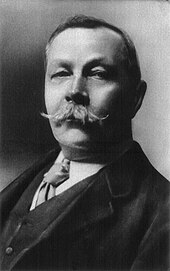George Edalji
George Ernest Thompson Edalji (March 1876 - June 17, 1953 in Welwyn Garden City ) was a solicitor from the English West Midlands who became known throughout Europe in 1906 as a victim of a British miscarriage of justice and through the efforts of the writer Arthur Conan Doyle for his cause . George Edalji was accused in 1903 of mutilating a horse and seriously injuring it. He was initially found guilty and was imprisoned for three years. It was only after Conan Doyle stood up for him and conducted investigations into his case himself that the sentence was overturned.
history
George Edalji's father Shapurji Edalji was born a Parse in Bombay . After being converted to Christianity by British missionaries, he studied theology in England and, in 1876, was given a pastorate in Great Wyrley , Staffordshire . His mother Charlotte, nee Stoneham, came from Scotland. George grew up in the Great Wyrley Rectory, the oldest of three children. A large part of the rural population harbored prejudice against Indians and wanted to evict the family. Racist insults, graffiti on the rectory and tasteless jokes soon followed. From the late 1870s onwards, the Edaljis repeatedly received anonymous threatening letters, initially attacking their parents and later particularly George Edalji. In the name of Shapurji or George Edalji, defamatory newspaper advertisements and various orders for goods were placed. They received threatening letters intermittently for about 20 years. The local police did nothing about the persecution of the family. Captain Anson, second son of the Earl of Lichfield and Chief Constable of Staffordshire, said the family had to blame the annoyance itself: "Hindus" did not belong in Staffordshire and had to reckon with problems there. Eventually he suspected George Edalji of having written the letters himself.
After attending school, George studied English law in Birmingham . He was a good student and won several awards from the Law Society of England and Wales . He then worked in Birmingham as an advisory lawyer (" Solicitor "). He still lived in the Great Wyrley Rectory and commuted to Birmingham by train. He discovered his interest in the railway law and wrote as an aid for rail travelers, the book Railway Law for the "Man in the train" .
process
In 1903, several sheep, cows and horses were mutilated in the Great Wyrley area. At night their abdominal wall was ripped open with a sharp weapon, the animals bled to death or had to be killed. Anonymous letters reappeared in which George Edalji was responsible for these acts. The police investigated exclusively in this direction. Police arrested George Edalji after another horse was mutilated near the parsonage. No other leads were followed. A local youth who was later arrested for committing a similar crime while George was in custody was allowed to leave the country and immigrate to South Africa.
Edalji's trial took place in a "Court of Quarter Sessions" , a local court with a presiding judge and lay judge. The prosecution was based on a few pieces of evidence: the proximity of the crime scene to the rectory; several razors were found there; Few traces of blood and mammalian hair were found on George's dressing gown. The most important argument cited was a manuscript report, according to which George was the author of the anonymous letters. Despite the scant evidence, George Edalji was sentenced to seven years in prison.
The next horse mutilation took place six months after the conviction. The confessed perpetrator was sentenced to three years in prison. The manuscript expert, on whose opinion the indictment against Edalji was based, had to admit that he had made a mistake in another case (in the trial against Adolph Beck ). Even so, Edalji remained in custody.
Public support
R. D. Yelverton and others turned to the press and petitioned George's conviction, which was signed by ten thousand citizens. Finally he was released early in 1906 after three years in prison. No reason was given and Edalji was given a criminal record, which made it impossible to work as a solicitor. Truth magazine reported on his fate. Finally, the writer Arthur Conan Doyle became aware of the case and started his own investigations in December 1906. He had new manuscript reports carried out, which excluded Edalji as the author of the letters. Another expert opinion showed that the injuries to the animals could not have come from razors; the sand on George's boots was of a different type of soil than at the crime scene; both the animal murders and the anonymous letters continue after his arrest. At his first meeting with Edalji in January 1907, Conan Doyle, who had practiced as an ophthalmologist for eight years, diagnosed him with severe nearsightedness and astigmatism . He was convinced that Edalji could not possibly have committed the act at night in rough terrain, just because of his poor eyesight.
Conan Doyle published his findings in several newspaper articles for the Daily Telegraph and urged the responsible Home Office to re-investigate the case because there were no appeals courts at the time. The reports were printed by other British daily newspapers, and articles on the case were also published abroad. Because of the great publicity of the articles, Home Secretary Herbert Gladstone finally set up a commission of inquiry. This published its final report in the spring of 1907. George Edalji is fully acquitted of the allegations of having been involved in the mutilation. The report admits a number of procedural errors and presents the evidence that led to the conviction as meaningless. Edalji was no longer considered a criminal record , was re-admitted to the English Law Society and was able to work as a lawyer again from then on. At the same time, however, the commission of inquiry was required to admit as far as possible no mistakes by the Staffordshire Constabulary - i.e. the local police - and not to fix any compensation. Therefore, in spite of expert opinions to the contrary, the commission upheld the allegation that Edalji himself wrote the anonymous letters accusing him of the acts. He is therefore responsible for the suspicion of being a perpetrator; the police are not to be blamed. Therefore Edalji is not entitled to any compensation.
Other events
Shortly thereafter, there was further animal mutilation in Staffordshire. The local police took a local to justice who had campaigned for Edalji's relief. He was acquitted. Arthur Conan Doyle tried several times in the next five years, unsuccessfully, to have the decision of the commission of inquiry revised so that Edalji would be completely exonerated and receive compensation. He attacked the chief of the Staffordshire Constabulary, Captain Anson, personally. George Edalji himself moved to London and worked there as a lawyer.
In 1907 the Court of Criminal Appeal , the first British appeals court , was established. The occasion was the public debate about the misjudgments against Adolph Beck and George Edalji.
literature
- Gordon Weaver: Conan Doyle and the Parson's Son: The George Edalji Case . Vanguard Press 2006. ISBN 978-1843862413 .
- Michael Klein: Epilogue to Arthur Conan Doyle: The Oscar Slater case , Halle (Saale), 2016, pp. 118–128.
Literary processing
- Julian Barnes , Arthur & George (novel). German 2007. ISBN 3-462-03706-4 .
Film adaptations
- 1966 Conan Doyle and the Edalji case
- 2015 Arthur & George mini-series in 3 parts
Web links
- Conan Doyle and The Parson's Son: The George Edalji Case
- Birmingham City Council biography
- Conan Doyle and The George Edalji Case
| personal data | |
|---|---|
| SURNAME | Edalji, George |
| ALTERNATIVE NAMES | Edalji, George Ernest Thompson (full name) |
| BRIEF DESCRIPTION | English legal advisor (solicitor) |
| DATE OF BIRTH | March 1876 |
| DATE OF DEATH | June 17, 1953 |
| Place of death | Welwyn Garden City |

